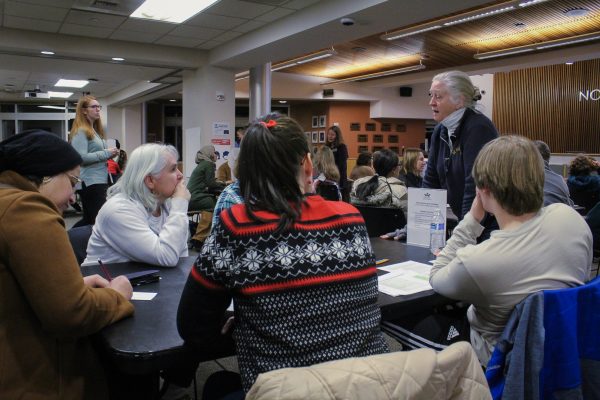At 6 p.m. on Dec. 12, NSD students, staff, parents and school board members gathered at the Admin Center in Bothell to discuss solutions to the district’s budget shortfall. NSD currently faces a shortfall of $22 million for the 2024-25 school year. Proposed solutions include a six-period instead of seven-period school day, cuts to activity coordinators and cuts to middle school sports.
NSD’s Deputy Superintendent and Chief Financial Officer JoLynn Berge (she/her) outlined NSD’s approach to making budget cuts.

“We are to consider making sure that we’re honoring our strategic plan, focusing on racial and educational justice as well as student outcomes,” Berge said. “We’re to make sure that we’re minimizing impacts on students both in the classroom and in their educational experiences, keeping schools open, making sure we’re complying with our agreements with our labor unions and our staff, minimizing any reduction in staffing or reduction in force preserving and making sure that we’re maintaining consistent Operations and Support Services, complying with state mandates, funded or not, and we’ll talk about the independent parts and then conforming with school district policies.”
Seventy-one percent of NSD’s revenue comes from state funding, which is based on district enrollment rates. The next biggest source of funding is from local levies, at 18%. School districts aren’t able to create new revenue; they must have more enrollment to get more money. Each May, districts estimate the next school year’s enrollment and make financial plans based on that estimate. They finalize employment contracts with teachers in May but determine the final budget in November.
Enrollment has been on the decline since a peak in the 2019-20 school year at 22,952. As of Oct. 1, NSD’s enrollment is 22,042. Lower birth rates and the pandemic have contributed to this decline, Berge said.
“For example, our 10th grade class or ninth grade class, there’s about 1,700 students in each of those classes across the district. Our incoming kindergarten class was 1,450. And that’s very similar to what other districts are seeing in their new cohorts coming in,” Berge said.
In the 2022-23 school year, NSD spent $26 million of local levy funds on top of state funds to cover the full cost of special education services. Special education services are required by law, but the state only funded about a third of what NSD needed for those services last year.
“One of the things that we had heard from the legislature last year was that they were going to fully fund special education in our state. They knew it was a problem; they knew that they were behind in funding what districts had actually been spending and the staffing that we had been providing to our schools and the services,” Berge said. “We needed them to come in at about $26 million and we ended up getting $9 million.”

Senior and ASB president Aylin Dutt (she/her) advocated to keep seventh period and avoid cuts to activity coordinators. Dutt said that eliminating seventh period limits teacher availability, which would harm equitable education programs like AVID. She also said it is important to keep school enjoyable for kids.
“There’s proposed cuts for activity coordinators and athletic directors on there, and I think that if we want to build communities for our students and make school something they care about and something they want to be at and retaining those students, you’re going to need to support those programs,” Dutt said in a speech at the meeting.
Several parents shared the experience of their kids in NSD’s special education programs. Stephanie Powell (she/her), who has a son in the sensory program, said support for paraeducators is just as important as support for teachers.
“My son was assaulted on the playground last week, punched in the head by a very, very angry seeming [student]. He was pursued to his classroom and resulted in a safe inside. It was a horrifying circumstance, but the child — the attacker — was blocked by one of the paras,” Powell said. “And so I think any reduction in staff is going to be extremely detrimental.”

Recently, school board director Jaqueline McGourty signed a multi-district letter to the state legislature that outlined short-term and long-term solutions to school funding issues. The short-term solution is for the state to set aside 44% of its forecasted $1.2 billion budget surplus for public education. The long-term solution is to create a two-year task force for a revised public education funding model. Berge said she’s seen similar budget issues in the past.
“It’s solvable. And it’s solvable by the state legislature,” Berge said. “We’re the paramount duty — we’re the only paramount duty in the Constitution.”










